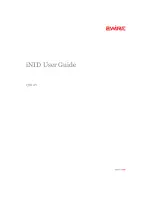
the program you put in it to make it do things. The program came to be known
as the software.
Hub
- The device that serves as the central location for attaching wires from
workstations. Can be passive, where there is no amplification of the signals; or
active, where the hubs are used like repeaters to provide an extension of the
cable that connects to a workstation.
IEEE
- The Institute of Electrical and Electronics Engineers. The IEEE
describes itself as “the world’s largest technical professional society—promot-
ing the development and application of electrotechnology and allied sciences for
the benefit of humanity, the advancement of the profession, and the well-being
of our members.”
The IEEE fosters the development of standards that often become national and
international standards. The organization publishes a number of journals, has
many local chapters, and has several large societies in special areas, such as the
IEEE Computer Society.
IP Address
- In the most widely installed level of the Internet Protocol (IP)
today, an IP address is a 32-binary digit number that identifies each sender or
receiver of information that is sent in packets across the Internet. When you
request an HTML page or send e-mail, the Internet Protocol part of TCP/IP
includes your IP address in the message (actually, in each of the packets if more
than one is required) and sends it to the IP address that is obtained by looking
up the domain name in the Uniform Resource Locator you requested or in the
e-mail address you're sending a note to. At the other end, the recipient can see
the IP address of the Web page requestor or the e-mail sender and can respond
by sending another message using the IP address it received.
IPCONFIG
- A utility that provides for querying, defining and managing IP
addresses within a network. A commonly used utility, under Windows NT and
2000, for configuring networks with static IP addresses.
IPSec
- IPSec (
I
nternet
P
rotocol
Sec
urity) is a developing standard for security
at the network or packet processing layer of network communication. A big
advantage of IPSec is that security arrangements can be handled without requir-
ing changes to individual user computers.
IRQ
(
I
nterrupt
R
e
Q
uest) - A hardware interrupt on a PC. There are 16 IRQ
lines used to signal the CPU that a peripheral event has started or terminated.
Except for PCI devices, two devices cannot use the same line.
83
enterprise with an intranet that allows its workers access to the wider Internet
installs a firewall to prevent outsiders from accessing its own private data
resources and for controlling what outside resources to which its own users have
access.
Basically, a firewall, working closely with a router, examines each network
packet to determine whether to forward it toward its destination.
Firmware
- Programming that is inserted into programmable read-only memo-
ry, thus becoming a permanent part of a computing device.
Fragmentation
- Breaking a packet into smaller units when transmitting over a
network medium that cannot support the original size of the packet.
FTP
(
F
ile
T
ransfer
P
rotocol) - A protocol used to transfer files over a TCP/IP
network (Internet, UNIX, etc.). For example, after developing the HTML pages
for a website on a local machine, they are typically uploaded to the Web server
using FTP.
FTP includes functions to log onto the network, list directories, and copy files.
It can also convert between the ASCII and EBCDIC character codes. FTP oper-
ations can be performed by typing commands at a command prompt or via an
FTP utility running under a graphical interface such as Windows. FTP transfers
can also be initiated from within a Web browser by entering the URL preceded
with ftp://.
Unlike e-mail programs in which graphics and program files have to be
“attached,” FTP is designed to handle binary files directly and does not add the
overhead of encoding and decoding the data.
Full Duplex
- The ability of a device or line to transmit data simultaneously in
both directions.
Gateway
– A device that interconnects networks with different, incompatible
communications protocols.
Half Duplex
- Data transmission that can occur in two directions over a single
line, but only one direction at a time.
Hardware
- Hardware is the physical aspect of computers, telecommunications,
and other information technology devices. The term arose as a way to distin-
guish the “box” and the electronic circuitry and components of a computer from
82










































